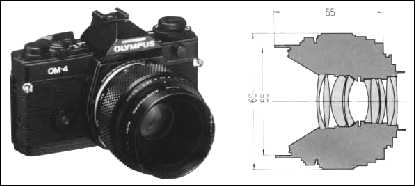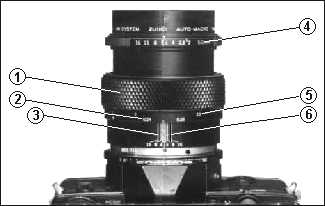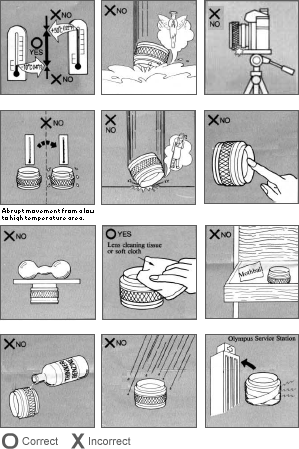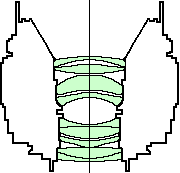Olympus OM system close-up and macro equipment
Zuiko Auto-Macro Lens 50mm f/2
Introduction
The 50mm f/2 Macro Zuiko is a member of the second series of OM lenses, which were designed with an emphasis on large maximum aperture and high performance, without the concern for small size that characterised the first series, including the 50mm f/3.5 Macro Zuiko. The lens was designed for optimum performance at a magnification of ×0.1, and the floating elements minimise the aberrations that would normally be expected at higher and lower magnifications. Olympus promoted this as the fastest macro lens on the market, and its f/2 maximum aperture does help to keep the viewfinder bright even at full extension. However, there was a faster macro lens, the Kern-Macro-Switar 50mm f/1.9 for the Alpa system, which was still being made in small numbers in the 1980’s.
The lens can focus from infinity to ½ life size. With the addition of a 25 mm Auto Extension Tube, the focusing range can be altered to cover ½ life size to life size (1:1). The extended focusing range compared with a standard 50mm lens requires a longer focusing helicoid, and in order to accommodate this the front element is recessed, providing a built-in lens hood.
The non-macro Zuiko lenses have 2 focusing scales, one in feet with orange markings and the other in metres with white markings. The 50mm f/2 Macro Zuiko does not follow this pattern, and has a magnification scale with yellow markings plus one focusing scale in either feet (orange) or metres (white), and so there are separate versions with metric and Imperial focusing scales.
The large diameter of the lens prevents it from being used with some tripods and copy stands that have large attachment plates.
Versions
- ZUIKO AUTO-MACRO 50mm 1:2 (101xxx, 102xxx, 103xxx, 105xxx, 106xxx, 107xxx, 113xxx)
- focusing scale in feet
- focusing scale in metres
- ZUIKO AUTO-MACRO f=50mm 1:2 (112xxx, 113xxx)
- focusing scale in feet
- focusing scale in metres
Features
|
|
Maximum magnification
| Magnification | ×0.5 | Subject area | 72×48 mm 2.8×1.9 in |
Working distance | ? mm |
|---|
Maximum magnification (with 25 mm Extension Tube)
| Magnification | ×1 | Subject area | 36×24 mm | Working distance | ? mm |
|---|
Accessories
The Macro Flash Shoe Ring screws into the 55 mm filter mount, and takes the heads of the T28 Macro Twin Flash 1 or the T28 Macro Single Flash 1.
Instruction leaflet
Reproduced with permission from the copyright owner, Olympus Optical Co., Ltd
ZUIKO AUTO-MACRO 50MM 1:2

This standard macro lens covers a wide focusing range from infinity down to ½× close-ups. With its large aperture ratio of F2, it expands your picture-taking scope and insures superb picture sharpness.
• Names of parts
|
 |
Specifications
- Focal length: 50 mm
- Angle of view: 47°
- Optical construction: 9 elements in 7 groups, multi-coated
- Diaphragm operation: Automatic
- Minimum aperture: F16
- Minimum focus: 0.24 m (0.8′)
- Min. field size: 48 × 72 mm (1.9″ × 2.8″)
- Focusing: Straight helicoid
- Weight: 320 g (11.3 oz.)
- Length: 55 mm (2.2″)
- Maximum diam.: 69 mm (2.7″)
- Filter size: 55 mm screw in
* Combined with an auto extension tube or bellows, this lens permits magnifications higher than ½×. For best results, use special macro lenses suited for your desired magnification.
• Depth of Field Table (in metres)
| F stop | Distance scale — Camera-to-subject distance | |||||||||
|---|---|---|---|---|---|---|---|---|---|---|
| *0.24 | *0.25 | *0.3 | *0.4 | *0.5 | *0.7 | *1 | 2 | *3 | *∞ | |
| 2 | 0.24–0.24 | 0.25–0.25 | 0.30–0.30 | 0.40–0.40 | 0.50–0.50 | 0.69–0.71 | 0.98–1.02 | 1.91–2.10 | 2.80–3.23 | 40.0–∞ |
| 2.8 | 0.24–0.24 | 0.25–0.25 | 0.30–0.30 | 0.40–0.40 | 0.49–0.51 | 0.69–0.71 | 0.97–1.03 | 1.88–2.14 | 2.73–3.33 | 28.6–∞ |
| 4 | 0.24–0.24 | 0.25–0.25 | 0.30–0.30 | 0.40–0.40 | 0.49–0.51 | 0.68–0.72 | 0.96–1.04 | 1.83–2.20 | 2.63–3.50 | 20.0–∞ |
| 5.6 | 0.23–0.23 | 0.25–0.25 | 0.30–0.30 | 0.39–0.41 | 0.49–0.51 | 0.68–0.73 | 0.95–1.06 | 1.77–2.30 | 2.51–3.75 | 14.3–∞ |
| 8 | 0.24–0.24 | 0.25–0.25 | 0.30–0.30 | 0.39–0.41 | 0.48–0.52 | 0.67–0.74 | 0.92–1.09 | 1.69–2.45 | 2.34–4.20 | 10.1–∞ |
| 11 | 0.24–0.24 | 0.25–0.25 | 0.29–0.31 | 0.39–0.41 | 0.48–0.52 | 0.65–0.76 | 0.90–1.13 | 1.60–2.68 | 2.16–4.94 | 7.33–∞ |
| 16 | 0.24–0.24 | 0.25–0.25 | 0.29–0.31 | 0.38–0.42 | 0.47–0.54 | 0.63–0.79 | 0.86–1.20 | 1.47–3.18 | 1.92–7.02 | 5.06–∞ |
Circle of least confusion 1/30 mm.
Figures with * are engraved on the distance scale.
• Depth of Field Table (in feet)
| F stop | Distance scale — Camera–to–subject distance (feet) | ||||||||||
|---|---|---|---|---|---|---|---|---|---|---|---|
| *9.5″ | *10″ | *11″ | *1 | *1.25 | *1.5 | *2 | *3 | *4 | *6 | *∞ | |
| 2 | 0.79–0.79 | 0.83–0.83 | 0.91–0.92 | 1.00–1.00 | 1.24–1.26 | 1.49–1.51 | 1.98–2.02 | 2.95–3.06 | 3.90–4.11 | 5.76–6.26 | 130–∞ |
| 2.8 | 0.79–0.79 | 0.83–0.84 | 0.91–0.92 | 1.00–1.00 | 1.24–1.26 | 1.48–1.52 | 1.97–2.03 | 2.92–3.08 | 3.86–4.15 | 5.67–6.37 | 93.2–∞ |
| 4 | 0.79–0.79 | 0.83–0.84 | 0.91–0.92 | 0.99–1.01 | 1.24–1.26 | 1.48–1.52 | 1.96–2.05 | 2.89–3.12 | 3.80–4.22 | 5.54–6.55 | 65.5–∞ |
| 5.6 | 0.79–0.80 | 0.83–0.84 | 0.91–0.92 | 0.99–1.01 | 1.23–1.27 | 1.47–1.53 | 1.94–2.07 | 2.85–3.17 | 3.73–4.32 | 5.38–6.80 | 46.9–∞ |
| 8 | 0.79–0.80 | 0.83–0.84 | 0.91–0.93 | 0.99–1.01 | 1.22–1.28 | 1.46–1.55 | 1.92–2.09 | 2.79–3.25 | 3.62–4.48 | 5.15–7.21 | 32.9–∞ |
| 11 | 0.78–0.80 | 0.82–0.84 | 0.90–0.93 | 0.98–1.02 | 1.21–1.29 | 1.44–1.56 | 1.89–2.13 | 2.72–3.35 | 3.50–4.69 | 4.89–7.80 | 24.0–∞ |
| 16 | 0.78–0.80 | 0.82–0.85 | 0.90–0.94 | 0.97–1.03 | 1.20–1.31 | 1.42–1.59 | 1.84–2.20 | 2.61–3.54 | 3.31–5.09 | 4.51–9.04 | 16.6–∞ |
Circle of least confusion 1/760 in.
Figures with * are engraved on the distance scale.
• Care and Storage

• Compatible focusing screens:
1-1 |
1-2 |
1-3 |
1-4N |
1-5 |
1-6 |
1-10 |
1-13 |
1-14 |
|
| Manual exposure | ○ | ○ | ○ | ○ | ○ | ○ | ○ | ○ | ○ |
|---|---|---|---|---|---|---|---|---|---|
| Automatic exposure | ○ | ○ | ○ | ○ | ○ | ○ | ○ | ○ | ○ |
| Finder exposure indication | ○ | ○ | ○ | ○ | ✗ (OM2N OM1N) |
✗ (OM2N OM1N) |
○ | ○ | ○ |
OLYMPUS
OLYMPUS OPTICAL CO., LTD.
San-Ei Building, 22-2, Nishi Shinjuku 1-chome, Shinjuku-ku, Tokyo, Japan
Exploded parts diagram
Send comments or questions to Alan Wood
![]()
Created 18th May 2001 — Updated 28th February 2021
Copyright © 2001–2021 Alan Wood
